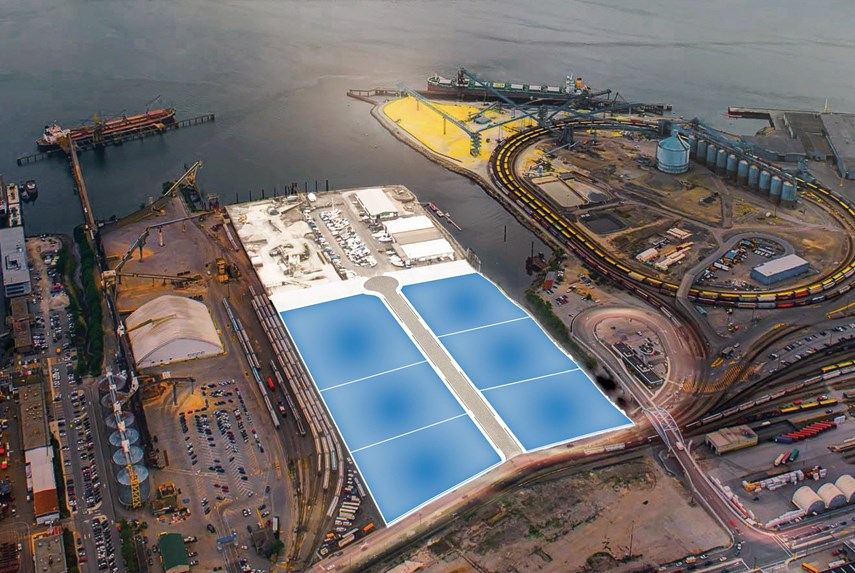A 27-acre industrial waterfront property that sold for $115 million in 2017 may get sliced into seven parcels, depending on the decision of the District of North Vancouver’s approving officer.
Employing less than one person per acre, Wesbild’s “underutilized” 1371 McKeen Ave. property should be reconfigured to allow opportunities for smaller local businesses, according to company senior vice-president of real estate Steve Forrest.
Occupied by a marina and concrete plant, the site is located on the lip of the inlet beneath the North Shore Wastewater Treatment Plant and sandwiched by Seaspan and the CN Rail yards. If approved, the subdivision would split the property roughly in half with an 11.6-acre parcel on the south side and six lots ranging from 0.67 to four acres on the north side. While the south side would continue functioning as a port, the northern 15 acres could be used for a variety of businesses. A website promoting the development touts film production, a food commissary, e-commerce, as well as a craft brewery or daycare.
That vision is a stark contrast from a muddy work site dotted with heavy equipment, said Mayor Mike Little during a council discussion.
“It looked more like a college campus than it looked like an industrial space,” he said.
Before making his final decision on the project, the district’s approving officer Dan Milburn opted to hear from council at a June 17 meeting.
Little noted that escalating international demand for Canadian products could be stymied on the North Shore due to limited rail capacity. He also discussed the dilemma of finding space for businesses that work with – but not on – the port.
“A lot of the businesses that come to support us, come a long way,” he said. “For the North Shore this is a particularly difficult problem because all of those businesses now have to cross our bridges.”
Businesses are continually looking for alternatives to urban sprawl, according to Wesbild vice-president of development and construction Derek Read.
Rather than one big hub, distributors are shifting to “smaller, more localized,” centres for last-mile delivery, Read wrote in a letter to the district.
If approved, the subdivision would imperil every business in the area, according to Pemberton merchant and frequent council watcher Lyle Craver.
Wesbild’s purchase of the site for three times its assessed value was the catalyst for a huge increase in property taxes, which trickled down to business owners through triple net leases, according to Craver.
“Council, you are picking winners and losers here and if this goes ahead, I am a loser,” he said.
Craver’s concern echoed the summation of North �鶹��ýӳ��Chamber CEO Patrick Stafford-Smith, who warned of what he termed: “the Coal Harbour effect.”
The site’s property value has risen to a level where it is “no longer economically viable for industrial logistics activity,” Stafford-Smith wrote.
The requested subdivision will have a “cascading impact on assessments” for similar industrial parcels, he added.
Writing on behalf of the Port of Vancouver, vice-president of planning Peter Xotta opted not to support the subdivision. Besides pushing up land values, the change would diminish the supply of land to move goods and introduce new uses – potentially conflicting with trade and goods movement.
According to Metro Vancouver, the region’s industrial land base was reduced by 870 acres between 2010 and 2015. The port is trying to buy waterfront industrial land to ensure competitiveness for Canadian importers and exporters, “but we have often been outbid by developers who buy at inflated prices with the intent to seek rezoning, subdivision or stratification,” Xotta wrote.
Decrying loss of waterfront access over the years, Pemberton Heights Community Association treasurer Herman Mah lauded the project for including a path to the foreshore.
“Many of our neighbours would like to enjoy access to the ocean in this way,” Mah wrote in a letter to the district.
Wesbild has expressed willingness to share costs on a Pemberton Avenue pedestrian bridge.
The subdivision would also improve opportunities for new businesses in the community, according to Mah.
“This will result in a greater number of people enjoying the benefit of not having to cross a bridge to get to work,” Mah wrote.
The subdivision is complicated by the site’s distance from transit, according to Coun. Betty Forbes.
“If we intensify that, what is that going to do to parking?” she asked.
The district hasn’t created opportunities for industrial businesses to grow as the nature of industry evolved, said Coun. Mathew Bond.
“I don’t see those opportunities – at least in the short and medium term – being explored at any other site on the North Shore,” Bond said.
Coun. Lisa Muri opposed the change, suggesting it would: “further erode industrial land in the district.”
Coun. Megan Curren also spoke against the subdivision.
“I think there’s potential for some user conflict and so I think, on that alone, I don’t support this.”
Council’s primary consideration should be to preserve the land that can be used for large-scale port industries, according to Coun. Jim Hanson.
��



